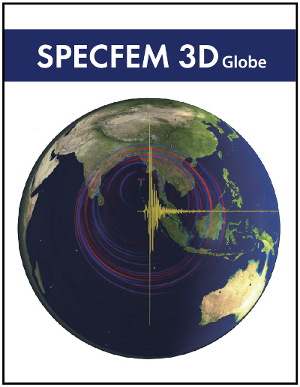Table of Contents
- Overview
- Introduction
- Part I: Setting up SPECFEM3D_GLOBE
- Part II: Continental-scale Simulations
- Part III: Visualization
- Part IV: Adjoint Simulations (Bonus)
- Further Work
- Resources
Introduction
SPECFEM3D_GLOBE
The software package SPECFEM3D_GLOBE simulates three-dimensional global and regional seismic wave propagation and performs full waveform imaging (FWI) or adjoint tomography based upon the spectral-element method (SEM).
It has very good accuracy and convergence properties. The spectral element approach admits spectral rates of convergence and allows exploiting (hp)-convergence schemes. It is also very well suited to parallel implementation on very large supercomputers as well as on clusters of GPU accelerating graphics cards.
Effects due to lateral variations in compressional-wave speed, shear-wave speed, density, a 3D crustal model, ellipticity, topography and bathymetry, the oceans, rotation, and self-gravitation are included. The package can accommodate full 21-parameter anisotropy as well as lateral variations in attenuation. Adjoint capabilities and finite-frequency kernel simulations are also included.

More information about the software package can be found in the SPECFEM3D_GLOBE manual:
South Napa Earthquake
The 2014 South Napa earthquake occurred in the North San Francisco Bay Area on August 24 at 03:20:44 Pacific Daylight Time. At 6.0 on the moment magnitude scale and with a maximum Mercalli intensity of VIII (Severe) the event was the largest in the San Francisco Bay Area since the 1989 Loma Prieta earthquake. It was located to the south of Napa and to the northwest of American Canyon on the West Napa Fault. Total damage in the southern Napa Valley and Vallejo areas was in the range of $362 million to 1 billion, with one person killed and 200 injured. Other aspects of the event included an experimental earthquake warning system that alerted seismologists several seconds before the damaging shear waves arrived, temporary changes in springs and wells, and the potential for postseismic fault creep.
A summary of the tectonic setting is provided by the USGS at the following link.